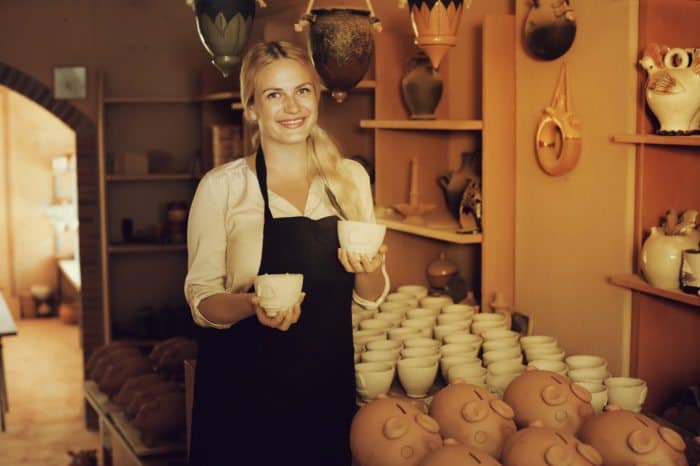Why We Love It
-
$35,710Potential Avg. Salary
-
Creativity FocusedCareer Attribute
-
Flexible HoursCareer Attribute
-
High Job SatisfactionCareer Attribute
Arts and crafts makers create both functional and displayable works of art and crafts out of a variety of materials and using a variety of tools. They sell their works in galleries, online, and at art and trade fairs.
Recommended Schools
What is an Arts and Crafts Maker?
The following job responsibilities are common for individuals in arts and crafts maker roles:
- Create art works and crafts using a variety of tools
- Adapt, utilize, and sculpt a variety of materials to create arts and crafts
- Market works in shops, online, in galleries, and at art, trade, and craft shows
- Design new creations and recreate popular pieces to increase sales
A Day in the Life
Arts and crafts makers are creative individuals who earn a living off of their talents. They envision, design, and create arts and crafts designed to be worn, used, or displayed. Arts and crafts makers use a variety of tools and materials to craft their works. For example, painters use paintbrushes, paint, canvasses, and other materials. On the other hand, woodworkers may use table saws, sanders, different types of wood, and wood burning tools to craft small and large wooden objects.
Most arts and crafts makers are self-employed and earn a living through direct sales of their arts and crafts. For this reason, they spend some percentage of their time creating works and some percentage selling them. Some artists operate their own galleries or share galleries with other artists and sell their works through the gallery. Some craft makers sell their goods online, work with shop owners to sell good in stores, or operate their own stores. Most arts and crafts makers occasionally rent booths at local and national art, craft, or trade shows.
Some art and craft makers create only individual, original pieces of art or crafts; others create single pieces and then have prints created or replicas made by other people to sell works in mass quantities. Generally, one-of-a-kind pieces can be sold for higher prices than replicas, though reproduced works can be sold at higher quantities. The type of arts and crafts maker an aspiring artist or craftsman wants to be is really an individual decision, and since they usually work for themselves, they can make that decision.
Typical Work Schedule
More than half of all arts and crafts makers are self-employed, so they can make their own schedules, work whenever they want, and put in as many or as few hours as they desire. Others are employed by museums or other businesses. These individuals typically work full-time, day shift schedules.
Arts and Crafts Maker Specializations
There are many different specializations of arts and crafts makers that use different materials and tools to create their arts and crafts. Below are some of the more common specialties:
- Ceramicists create cups, bowls, and other items using clay, pottery wheels, and kilns.
- Jewelry makers create necklaces, bracelets, earrings, rings, and other types of jewelry using beads, wires, connectors, and metal.
- Painters use canvasses, paint, easels, and other tools to create paintings.
- Woodworkers use different types of wood, saws, sanders, screws, nails, and wood burning tools to create different types of wood pieces, including furniture.
- Glassworkers use glass and different types of tools—like glassblowing equipment, torches, and glass staining materials—to create jewelry, knick-knacks, windows, and other pieces of art.
- Fiber artists create crafts and art works using different types of cloth, yarn, fiber, and other textiles using a variety of tools.
Typical Employers
Most arts and crafts makers are self-employed. Others help to perform restorations and care for items at museums, historical societies, and other institutions, and some work directly for businesses that produce ceramics, furniture, and other items.
Recommended Schools
How To Become an Arts and Crafts Maker
No formal postsecondary education is required to become an arts and crafts maker. Some are self-taught and can make a living off of their own talent and marketing/sales ability. Others learn their trade from family members or in an apprenticeship program, studying under an experienced artist. In many ways, being a successful arts and crafts maker is more about talent, originality, and creativity than any formal learning, so those with talent tend to succeed regardless of their level of education.
However, many art and craft makers want to receive a formal education in order to refine, extend, and perfect their skills and abilities. For these individuals, a bachelor’s degree in fine arts (BFA) is preferred. A BFA educates students on many different types of art forms and allows them to specialize on the one they are most interested in. Students also study the history of their preferred medium to get ideas for things to create in the future when designing their portfolio of art and craft products for sale.
Since most arts and crafts makers are self-employed, working towards a degree also offers opportunities to take business and marketing classes that can be beneficial for long-term success making a profit off of your art or running your own shop or business.
Arts and Crafts Maker Salary Data
We’ve provided you the following to learn more about this career. The salary and growth data on this page comes from recently published Bureau of Labor Statistics data while the recommendations and editorial content are based on our research.
National Anual Salary
Low Range
$23,010Average
$35,710High Range
$59,750National Hourly Wage
Low Range
$11/hrAverage
$17/hrHigh Range
$29/hrHow do Arts and Crafts Maker salaries stack up to other jobs across the country? Based on the latest jobs data nationwide, Arts and Crafts Maker's can make an average annual salary of $35,710, or $17 per hour. This makes it an Above Average Salary. On the lower end, they can make $23,010 or $11 per hour, perhaps when just starting out or based on the state you live in.
Salary Rankings And Facts
#608 Nationally for All Careers
Programs and Degrees
Here are the most common degrees for becoming an Arts and Crafts Maker. a is usually recommended and specifically a degree or coursework that prepares you for the particular field, see below.
Highest Education Among Arts and Crafts Makers
- 1.9% Doctorate
- 12% Masters
- 45% Bachelors
- 9% Associates
- 18.4% College
- 10.7% High School
- 3% Less than High School
Job Growth Projections and Forecast
2014 Total Jobs
10,6002024 Est. Jobs
10,600Job Growth Rate
---Est. New Jobs
---How does Arts and Crafts Maker job growth stack up to other jobs across the country? By 2024, there will be a change of --- jobs for a total of 10,600 people employed in the career nationwide. This is a --- change in growth over the next ten years, giving the career a growth rate nationwide of Below Average.
Growth Rankings And Facts
#594 Nationally for All Careers
What Companies Employ The Most Arts and Crafts Makers
| Industry | Current Jobs | New Jobs Needed | % Increase |
|---|---|---|---|
| Self-employed workers | 5,900 | 100 | 0% |
| Independent artists, writers, and performers | 1,700 | 100 | 0% |
| Clay product and refractory manufacturing | 400 | -100 | 0% |














